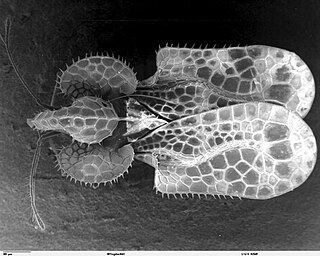
The Reduviidae is a large cosmopolitan family of the suborder Heteroptera of the order Hemiptera. Among the Hemiptera and together with the Nabidae almost all species are terrestrial ambush predators; most other predatory Hemiptera are aquatic. The main examples of non-predatory Reduviidae are some blood-sucking ectoparasites in the subfamily Triatominae, with a few species from South America noted for their ability to transmit Chagas disease. Though spectacular exceptions are known, most members of the family are fairly easily recognizable; they have a relatively narrow neck, sturdy build, and a formidable curved proboscis. Large specimens should be handled with caution, if at all, because they sometimes defend themselves with a very painful stab from the proboscis.

The Cimicomorpha are an infraorder of insects in the order Hemiptera, the true bugs. The rostrum and other morphology of all members apparently is adapted to feeding on animals as their prey or hosts. Members include bed bugs, bat bugs, assassin bugs, and pirate bugs.

The Emesinae, or thread-legged bugs, are a subfamily of the Reduviidae. They are conspicuously different from the other reduviids by their very slender body form. They are stalking, predatory insects that can be collected on palm fronds, cliffs, spider webbing, or near lights at night. They walk on their mid and hind legs; the front pair is raptorial. Some groups specialize on spiders. Very little is known about emesines except that many species are found in the tropics. Pedro Wygodzinsky wrote the most recent revision of this group.

The Harpactorinae are a large subfamily of the Reduviidae. About 300 genera and 2,000 species worldwide have been described. Some of the species of the genera Zelus, Pselliopus, Sinea, and Apiomerus are of interest as biological pest control agents.

Stenolemus is a genus of thread-legged bug (Emesinae). Species of this genus are noted for preying on spiders.

The Emesini is a tribe of thread-legged bugs.
Gardena is a genus of thread-legged bugs in the subfamily Emesinae. It is the second-largest genus in the tribe Emesini. Presently there are 46 described species.
The Leistarchini is a tribe of thread-legged bugs.

Ploiariolini is a tribe of thread-legged bugs, comprising 16 genera and 142 described species. Ploiariolini has a worldwide distribution.
Bagauda is a genus of thread-legged bug in the Emesinae. 18 species are currently known. Many of the species of this genus are associated with caves, some exclusively so. Bagauda is synonymous with the genus Pleias Kirkaldy, 1901, but Bagauda has become more widely used. The genus is restricted to Old World tropics.
Onychomesa is a little-known genus of thread-legged bug in the subfamily Emesinae. Three species have been described, one from India, Japan, and Taiwan.
The Collartidini is a tribe of thread-legged bugs restricted to Africa, Sri Lanka and Taiwan. Wygodzinsky (1966) proposed that this group is the sister group of the remaining Emesinae.

The Holoptilinae are a subfamily of Reduviidae known as feather-legged bugs or ant wolves. Several members of the subfamily specialize on ants. About 16 genera are known, with about 80 species described. Species in the Holoptilini tribe possess a specialized organ called a trichome to attract ants.

The Apiomerini are a tribe of the Harpactorinae. This tribe is restricted to the New World and consists of 11 genera.

Harpactorini is a tribe of the Harpactorinae. This group is the most diverse of the entire assassin bug family, with 51 genera recognized in the Neotropical Region and 289 genera and 2003 species overall.
The Centrocnemidinae are a subfamily of the reduviid, found exclusively on tree trunks, where their bodies camouflage well. There are four genera with about 34 species described.

The Stenopodainae are a subfamily of Reduviidae. Many species of this subfamily are endemic to tropical rainforests, and some smear their fore legs with sticky, plant-derived resin, to aid in prey capture.
The Peiratinae are a subfamily of assassin bugs (Reduviidae) known as corsairs. The subfamily has a worldwide distribution, but is concentrated in tropical areas. About 30 genera with 350 species are described.
Stenolemus alikakay is a species of assassin bug, family Reduviidae. It was first found in a spider web at Shanping Forest Ecological Science Park, Taiwan. It has later also been found on Ishigaki Island, the Ryukyu Islands, Japan.

Salyavatinae are a subfamily of the assassin bugs. They have a pan-tropical distribution with about 16 genera. They have two foretarsal segments and have a patch of fine hairs known as the fossula spongiosa on the fore and mid tibia. Many species tend to have spines on the head, pronotum, legs and abdomen. A few species have the foretibia flattened into leaf-like structures.









